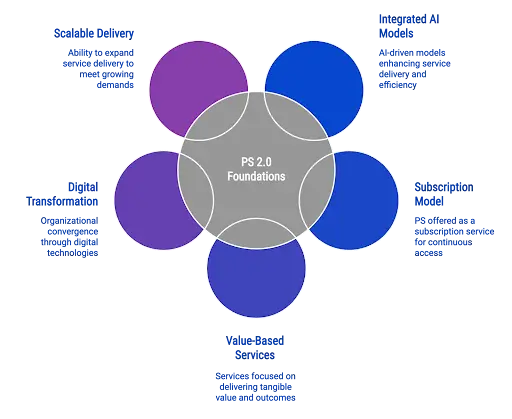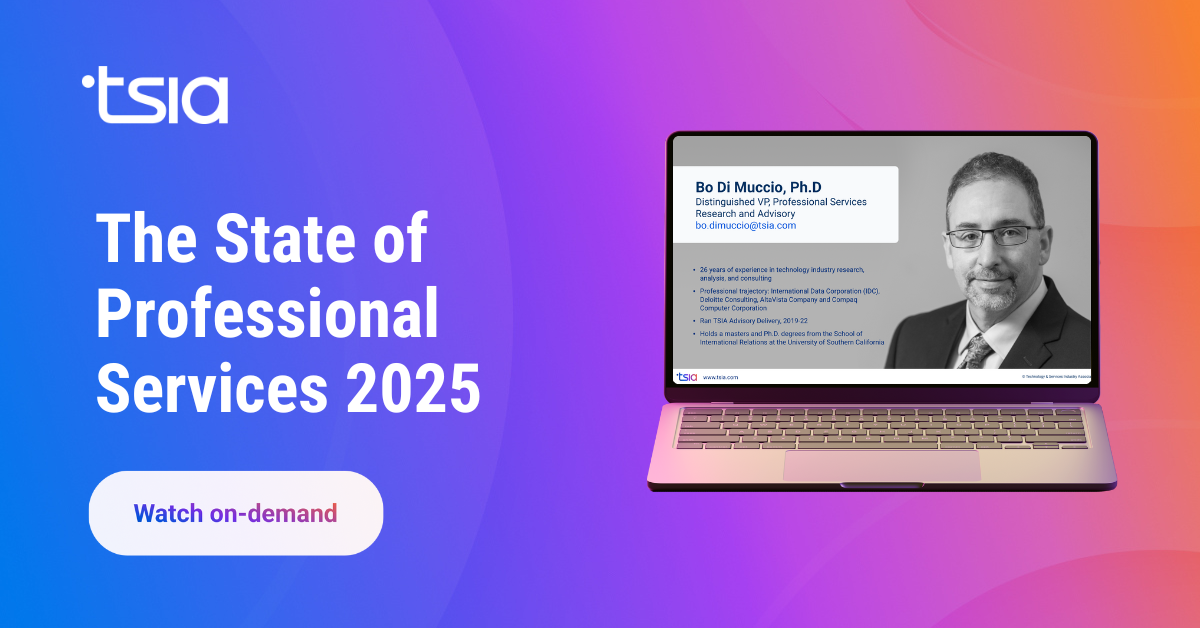The world of professional services is shifting faster than ever before. What once relied on traditional, project-based engagements is evolving into something more dynamic, customer-focused, and technology-driven. At TSIA, we call this shift Professional Services 2.0 (PS 2.0)—a fundamental transformation that redefines how you design, deliver, and measure value.
If you lead or work in a professional services organization, understanding Professional Services 2.0 isn’t optional. It’s the key to ensuring your business remains relevant, profitable, and aligned with customer expectations in the next five years.
Key Takeaways
- Professional Services 2.0 is outcome-driven: You’ll move away from measuring inputs like hours worked, and instead, focus on delivering measurable customer value.
- AI and digital are central: Future-ready organizations will integrate AI and digital tools directly into service design and delivery.
- Subscriptions replace one-offs: Renewable, value-based models like Professional Services-as-a-Service will outpace traditional project revenue streams.
The Shift From Professional Services 1.0 to Professional Services 2.0
Today, most professional services organizations (PSOs) still operate in what we call Professional Services 1.0: project-based, effort-focused, and tied to one-off revenue streams. While discussions about AI, subscription services, and outcome-based pricing are widespread, adoption has been slow and uneven.
The truth is clear: Professional Services 1.0 can’t last forever; customers are demanding more continuous value, faster results, and measurable outcomes. That’s where Professional Services 2.0 comes in.
Professional Services 2.0 reimagines services to emphasize:
- Integrated AI-powered models that enhance efficiency and create new service possibilities.
- Subscription-style engagement models that provide renewable revenue and stronger customer relationships.
- Outcome-based delivery where your value is measured by the impact you create, not the hours you bill.
- Digital transformation and organizational convergence that remove silos and accelerate innovation.
- Scalable service delivery to meet growing demand without ballooning costs.
Related: What Is Professional Services 2.0?
The Foundations of Professional Services 2.0
To understand Professional Services 2.0, it helps to look at its core foundations and how they differ from Professional Services 1.0.

Integrated, AI-Powered Models
In Professional Services 2.0, AI isn’t an experiment—it’s the backbone of how you deliver services. By weaving AI into workflows and client delivery, you can reduce costs, accelerate results, and even create entirely new offers.
For you, this means:
- Using AI to streamline internal processes.
- Enhancing customer experiences with more innovative delivery models.
- Exploring new revenue opportunities in AI-powered consulting and services.
Professional Services Subscription Model
Instead of “one-and-done” projects, Professional Services 2.0 emphasizes renewable, subscription-based services. This keeps you engaged with customers long after the initial project ends and ensures your revenue base grows steadily.
For your organization, success depends on:
- Expanding your portfolio to include subscription-style offers.
- Shifting from time-and-materials pricing to outcome-based pricing.
- Tracking customer lifetime value (CLTV) as a measure of success.
Focus on Value and Outcomes
Professional Services 1.0 was based on what you did. Professional Services 2.0 is about what your customers achieve because of you. Measuring customer outcomes and shortening time-to-value (TTV) become essential to proving your worth.
You’ll need to:
- Redesign services around outcomes, not deliverables.
- Demonstrate your role in increasing CLTV.
- Track and reduce customer TTV so clients see results faster.
Digital Transformation and Organizational Convergence
Professional Services 2.0 requires you to move beyond siloed operations. This means embedding digital tools across the organization and designing more connected, agile operating models.
This looks like:
- Adopting professional services automation (PSA) tools to boost efficiency.
- Building agile structures that adapt quickly to market changes.
- Encouraging collaboration across departments and partner ecosystems.
Scalable Delivery Models
Custom, one-off projects won’t get you where you need to be. In Professional Services 2.0, scalability is critical. You’ll rely on standardized, repeatable, and AI-enhanced processes that let you serve more customers without driving up costs.
This requires:
- Investing in services engineering frameworks.
- Creating standardized offers for repeatable delivery.
- Leveraging AI to support consistent, efficient client delivery.
Related: The State of Professional Services 2025: Navigating Transformation
Why Professional Services 2.0 Matters for Your Organization
The shift to Professional Services 2.0 is not incremental—it’s a wholesale redefinition of professional services. As AI adoption accelerates and customers demand more measurable value, the organizations that thrive will be those:
- Rethinking their operating models.
- Reimagining how they design and price services.
- Embracing digital tools and AI as core to their strategies.
If you’re still relying on project-based revenue, it’s time to consider how to transition toward subscription and outcome-focused models. Doing so will future-proof your services and ensure your customers view you as an essential, long-term partner.
Professional Services 2.0 is already here—and it’s gaining momentum. While Professional Services 1.0 defined the industry for decades, its limitations are becoming clearer by the day. By focusing on AI integration, renewable models, outcomes, digital transformation, and scalability, you’ll be positioned not just to survive, but to lead in the coming era of professional services.
Related: Boost Professional Services Impact With AI

FAQs
What is the most significant difference between Professional Services 1.0 and Professional Services 2.0?
Professional Services 1.0 is project-based and effort-focused, while Professional Services 2.0 is subscription-oriented, AI-powered, and outcome-driven. In Professional Services 2.0, your success depends on measurable customer results and renewable revenue streams.
How do I know if my organization is ready for Professional Services 2.0?
You’re ready if you’re actively exploring subscription-based services, AI use cases, and outcome-driven pricing models. If you’re still primarily dependent on one-off projects, now is the time to begin your shift.
What should I prioritize first in transitioning to Professional Services 2.0?
Start with service design—move from project deliverables to customer outcomes. From there, invest in AI-enabled tools and subscription models that align your success with your customers’ long-term value.
Smart Tip: Embrace Data-Driven Decision Making
Making smart, informed decisions is more crucial than ever. Leveraging TSIA’s in-depth insights and data-driven frameworks can help you navigate industry shifts confidently. Remember, in a world driven by artificial intelligence and digital transformation, the key to sustained success lies in making strategic decisions informed by reliable data, ensuring your role as a leader in your industry.













